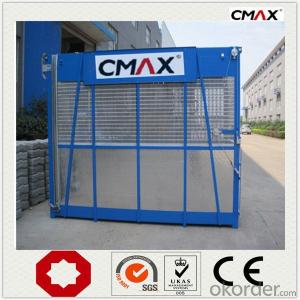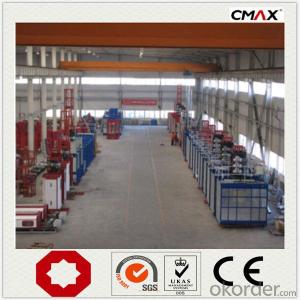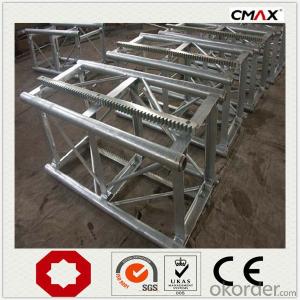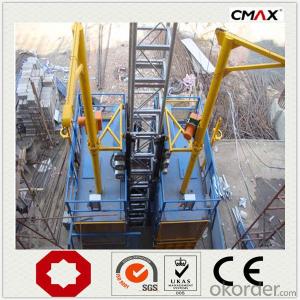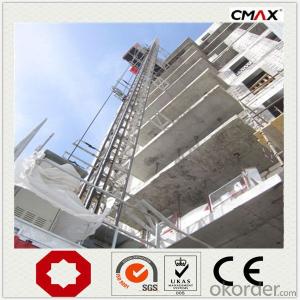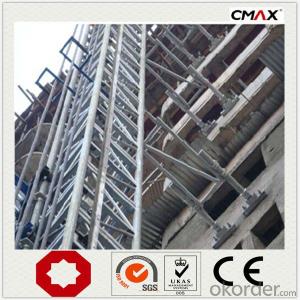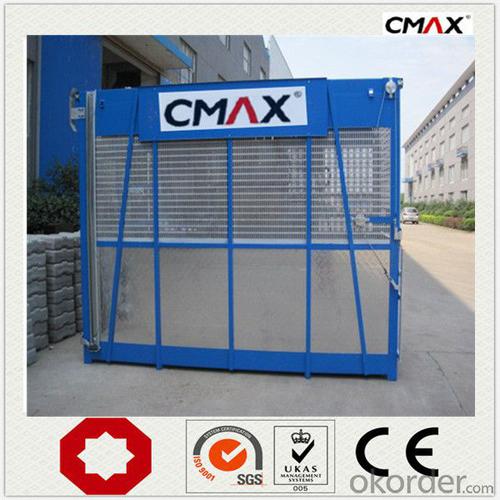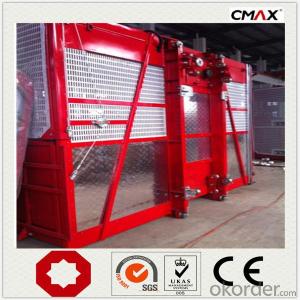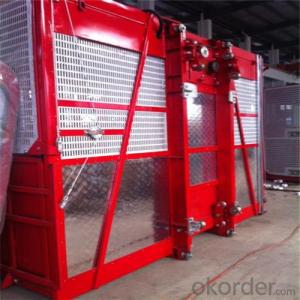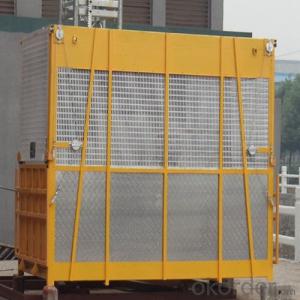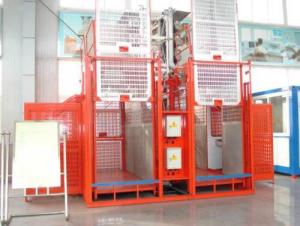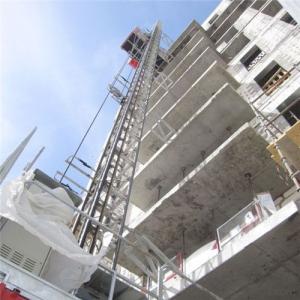Construction Hoist New SC160 Middle Speed
- Loading Port:
- China main port
- Payment Terms:
- TT or LC
- Min Order Qty:
- 1 unit
- Supply Capability:
- 100 unit/month
OKorder Service Pledge
OKorder Financial Service
You Might Also Like
Structure of SC160 Construction Hoist Description
To serve the increasing demand for highrise construction, we developed the high speed VF hoist, with a max.lifting speed of 96 m/min.
It has the following structure:
1. Adopts the most advanced VF speed control device and microcomputer programmable logic controller.
2. Stepless speed control helps eliminate the concussion during start up and braking, steady the operation process, and ensures automated leveling.
3. Adopts open loop V/F control: the speed control precision can reach ±2~3%. Realizes accurate low speed positioning of the hoist and avoids slipping during downward stopping of hoist.
4. The VF system has current-restriction function, ensuring a small current when motor start up and reducing the concussion to power supply. It reduces the energy consumption and mitigates effects to on site electric equipments.
5. The steadiness during running mitigates concussion to mechanical parts, reduces wears of rack,pinion and the brake and prolongs the spare parts'life.
6. The System applies the special software for hoists developed by our company, making the operation more safe and reliable.
Main Features of SC160 Construction Hoist
1. The recomended cage dimension(L*W*H)(m): 2.0*1.0*2.5, 2.5*1.0*2.5, 2.5*1.3*2.5, 3.0*1.5*2,5, 3.2*1.5*2.5, 3.8*1.5*2.5, 4.0*1.5*2.5, 4.2*1.5*2.5 etc. We can also manufacture cages of other size according to the user.
2. The cage and the door material can be aluminum molded board, punched-plate, figured aluminum board or other type according to yout requirements.
3. The mast section and the tie-in surface can adopt paint-spray, or hot galvanizing processing.
4. Both domestic and imported driving systems are available.
SC160 Construction Hoist Specifiction
SC series product also has special design, such as reinforced guide rail with cross-section of 800mm, inclined type, special for cooling tower, etc. All the double cage building hoist can be changed into single cage type,
| Type | Payload(kg) | Lifting Speed (m/min) | Motor Power(kw) | Safety Device | ||
| Single Cage Hoist | No Counterweight | SC100 | 1000 | 0~60 | 3*11 | SAJ30-1.4 |
| SC120 | 1200 | 0~60 | 3*11 | SAJ30-1.4 | ||
| SC160 | 1600 | 0~60 | 3*15 | SAJ30-1.4 | ||
| SC200 | 2000 | 0~60 | 3*15 | SAJ40-1.4 | ||
| SC250 | 2500 | 0~60 | 3*18.5 | SAJ50-1.4 | ||
| SC270 | 2700 | 0~60 | 3*18.5 | SAJ50-1.4 | ||
| SC300 | 3000 | 0~60 | 3*22 | SAJ50-1.4 | ||
| SC320 | 3200 | 0~60 | 3*22 | SAJ50-1.4 | ||
| With Counterweight | SCD200 | 2000 | 0~60 | 2*15 | SAJ40-1.4 | |
| SCD250 | 2500 | 0~60 | 2*18.5 | SAJ50-1.4 | ||
| SCD270 | 2700 | 0~60 | 2*18.5 | SAJ50-1.4 | ||
| SCD300 | 3000 | 0~60 | 3*15 | SAJ50-1.4 | ||
| SCD320 | 3200 | 0~60 | 3*15 | SAJ50-1.2 |
Images of SC160 Construction Hoist
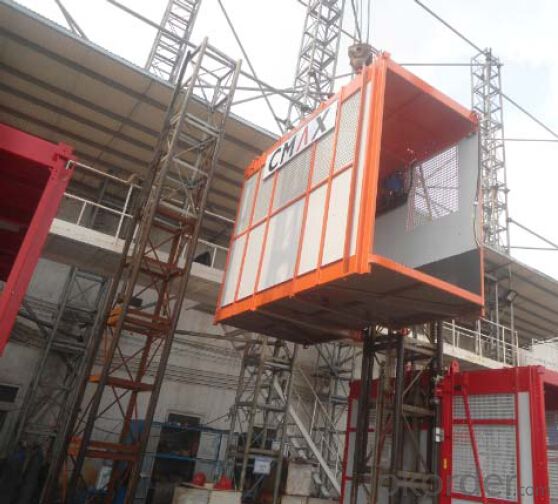
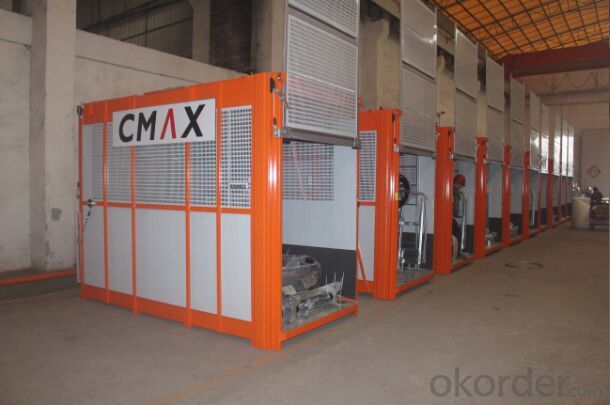
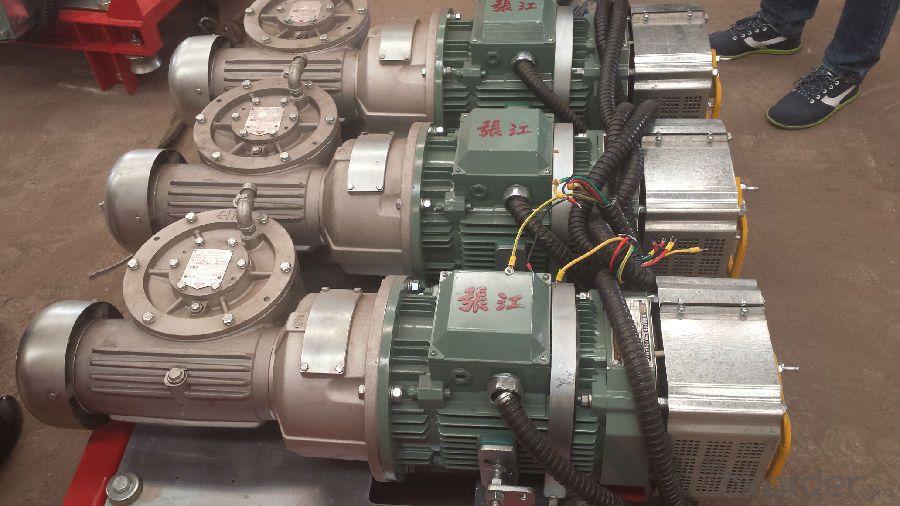
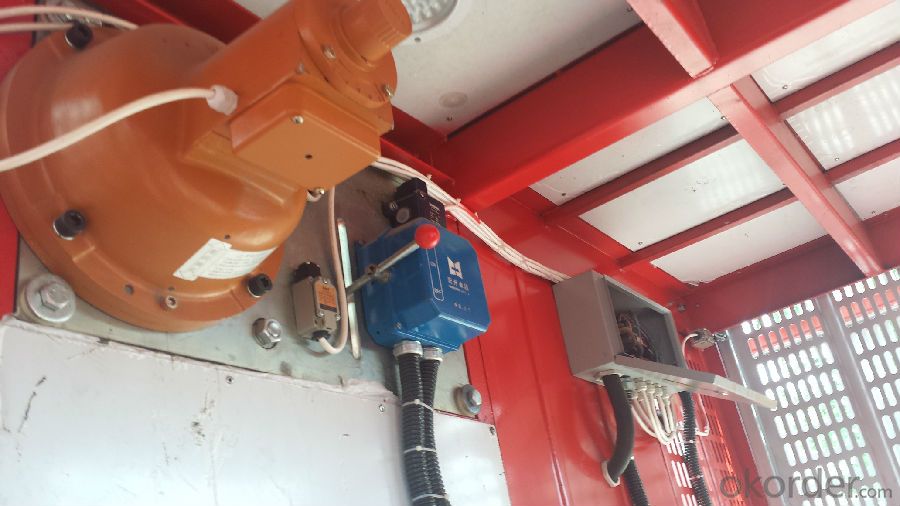
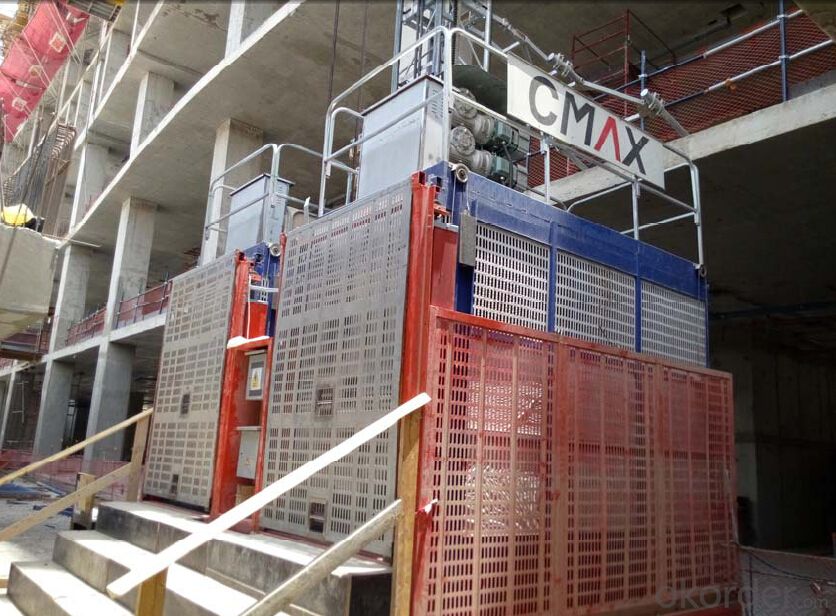
FAQ of SC160 Construction Hoist
Q: What is the building hoist main purpose?
A: Building hoist equipped with double or single cabin to transport the materials and labors up and down. It's the ideal
construction equipment for vertical transportation in the field of construction.
Q: What is the meaning of the building hoist’s code?
A: Take SC200/200 for example: “SC” stands for rack and pinion hoist, “200/200” stands for double cage and capacity is 2 tons per cage. “SC200” stands for single cage and capacity is 2 tons.
Q: What is the dimension of the cage?
A: Normally the cage dimension is 3X1.5X2.5M (L/W/H) for 2t type hoist. Details should be checked according to our quotation sheet. Also, the size can be customized according to the factual site condition. There are two doors (entrance& exit doors) for each cage, It can be produced as up & down sliding or ramping model for safety and convenience.
- Q: This question asks for the method to determine the lifting capacity of a building hoist.
- <p>To calculate the weight that a building hoist can lift, you need to consider the hoist's rated capacity, which is specified by the manufacturer. This rating is based on safety factors and should not be exceeded. Check the hoist's specifications for its maximum load capacity. Ensure that the weight of the materials being lifted does not exceed this limit. Additionally, consider the hoist's mechanical condition, the strength of the cables, and the stability of the lifting points. Regular maintenance and inspection are crucial to ensure the hoist operates within its safe working load limits. Always follow the manufacturer's guidelines and safety regulations when using a building hoist.</p>
- Q: This question asks if a building hoist can be utilized in both commercial and residential settings.
- <p>Yes, a building hoist can be used for both commercial and residential purposes. These hoists are designed to lift materials and workers to various levels of a building under construction. In commercial settings, they are often used in high-rise buildings, while in residential construction, they are used for multi-story homes or apartment complexes. However, the specific type and capacity of the hoist should be chosen based on the project's requirements and safety regulations must be strictly adhered to in both types of construction.</p>
- Q: This question asks if a building hoist is capable of lifting heavy objects.
- <p>Yes, a building hoist is specifically designed to lift large objects. It is a type of crane used in construction to move heavy materials and equipment to different levels of a building under construction. Building hoists can handle a significant weight, but the exact capacity depends on the specific model and its design specifications. They are essential for efficient construction processes, ensuring the safe and effective transportation of materials within the construction site.</p>
- Q: This question asks whether building hoists can be utilized in limited areas like rooms or tunnels.
- <p>Yes, building hoists can be used in confined spaces such as rooms or tunnels, but it depends on the specific design and size of the hoist. Compact and portable hoists are available for use in tight spaces. However, safety considerations, space dimensions, and the weight capacity of the hoist must be taken into account. It's crucial to ensure that the hoist is suitable for the confined area and that all safety protocols are followed to prevent accidents.</p>
- Q: Is it possible to use a building hoist for lifting fragile or delicate items?
- <p>A building hoist is generally designed for heavy construction materials and not for delicate objects. However, with the right attachments and careful operation, it can be adapted for lifting delicate items. It's crucial to ensure the hoist is equipped with appropriate stabilizers and cushioning to prevent damage. Always follow safety guidelines and consult with the manufacturer or a professional to determine if the hoist can be safely used for such purposes.</p>
- Q: This question asks about the typical issues encountered with building hoists and the methods to address these problems.
- <p>Common faults in building hoists include mechanical failures such as worn gears or chains, electrical issues like short circuits or malfunctioning controls, and structural problems such as misaligned guides or damaged safety devices. To deal with these issues, regular maintenance and inspection are crucial. Mechanical faults can often be resolved by replacing worn parts or lubricating moving components. Electrical problems may require a thorough check of wiring and control systems, possibly involving a qualified electrician. Structural issues might necessitate adjustments or repairs to ensure the hoist operates safely. In all cases, following the manufacturer's guidelines and safety protocols is essential to prevent accidents and ensure the hoist's reliable operation.</p>
- Q: This question asks for an identification of the various types of lifting equipment that are specifically utilized in the context of building hoists.
- <p>Different types of lifting equipment used for building hoists include: 1. Electric Chain Hoists, which are versatile and suitable for various lifting tasks. 2. Manual Chain Hoists, that require manual operation and are used for lighter loads. 3. Electric Wire Rope Hoists, known for their high lifting capacity and durability. 4. Air Hoists, which are powered by compressed air and are ideal for environments where electricity is hazardous. 5. Geared Winches, used for pulling or lifting heavy loads with precision. 6. Jib Cranes, which provide a fixed or semi-fixed lifting solution in workshops. 7. Gantry Cranes, used for lifting heavy loads over a specific area. Each type serves specific purposes and is chosen based on the weight, environment, and specific requirements of the construction project.</p>
- Q: This question asks for the method to determine the maximum weight a building hoist can lift.
- <p>The lifting capacity of a building hoist is calculated by considering several factors including the hoist's motor power, the strength of the hoist's construction materials, and the safety factor. The manufacturer usually provides the maximum lifting capacity based on these factors. To calculate it manually, you would need to know the motor's lifting force, the efficiency of the hoist's mechanical system, and apply a safety factor to ensure the hoist operates within safe limits. It's important to follow the manufacturer's guidelines and never exceed the specified lifting capacity to prevent accidents and ensure the hoist's longevity.</p>
- Q: This question asks whether a building hoist can be utilized in construction or demolition activities.
- <p>Yes, a building hoist can be used for both construction and demolition work. In construction, hoists are essential for transporting materials and personnel vertically within a building under construction. They are designed to handle heavy loads and operate safely at significant heights. In demolition, hoists can be used to remove debris and transport workers to different levels of a structure being dismantled. However, it's crucial to ensure that the hoist is suitable for the specific task and that all safety protocols are followed to prevent accidents.</p>
- Q: Is it possible for a hydraulic cylinder in a building hoist to experience leakage or failure?
- <p>Yes, a hydraulic cylinder in a building hoist can leak or break. Leaks can occur due to worn seals, damaged hoses, or corroded cylinder walls. Breakage may result from excessive pressure, manufacturing defects, or metal fatigue. Regular maintenance and inspection are crucial to detect and prevent such issues, ensuring the safety and efficiency of the hoist system.</p>
Send your message to us
Construction Hoist New SC160 Middle Speed
- Loading Port:
- China main port
- Payment Terms:
- TT or LC
- Min Order Qty:
- 1 unit
- Supply Capability:
- 100 unit/month
OKorder Service Pledge
OKorder Financial Service
Similar products
Hot products
Hot Searches
Related keywords
